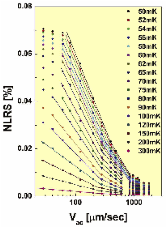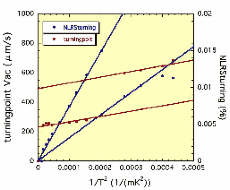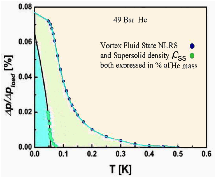Quantized Vortex Physics in hcp Solid 4He and Supersolid Transition Studied by Torsional Oscillator Technique
Kubota Group
Superfluidity has been found not only in the Bose fluid, liquid 4He and Fermi fluids, liquid 3He and conduction electrons in metals, but also in dilute gaseous materials. Superfluidity had been considered in the early days primarily as a result of Bose Einstein Condensation (BEC) of the constituent particles, which can exchange positions with each other. The original discussions as to the possibility of observing the “supersolidity”, or superfluidity in a solid were initiated in 1956 by Penrose and Onsager with a negative result, and positive discussions have gained strength in 1960’s, when experimental evidence of quantized circulation, as well as quantized flux in superconductors were discovered. It was 1972 when Kosterlitz and Thouless proposed a topological two dimensional transition, describing a 2D superfluid transition at a finite temperature TKT, involving 2D vortex anti-vortex pairs. Its realization was experimentally clearly shown by the study of a superfluid transition in a monolayer of He by Bishop and Reppy. We have been studying a series of artificial 3D superfluids in monolayers of He condensed on well controlled, porous glass substrates with fixed diameters [1]. We could show 3D vortex excitations in such a system both by theory [2] and experiments [3].

Fig.1. Detailed measurements of the non linear rotational susceptibility, NLRS of our 49 bar sample of hcp 4He, as a function of log Vac, a part of which has been published [4]. A much more detailed study is shown here. We observe the log Vaclinear relation is followed over some range ofVac, starting at a certain Vacvalue. Then some other logVaclinear like dependence appears at a higherVac range for each point at a T. And the turning points are plotted in Fig. 2., where a jump was found near Tc. The log Vac linear relation was discussed for solid 4He first by Anderson [5] as evidence for the involvement of quantized vortex lines in the physics of solid 4He, and is experimentally discussed by Penzev et al. [4] for vortex lines threading into or “polarizing” a tangled state of the VF.

Fig.2. The turning Vac points, as well as, corresponding NLRS points are plotted as a function of 1/T2. The jump corresponds to the transition temperature Tc.

Fig. 3. The extra energy dissipation under DC rotation divided by rotational speed Ω would give a normalized energy dissipation per unit of vortex line density(left). It gives a unique T dependence and is compared with the hysteretic component of the TO response(right). It supports the idea that the hysteretic component of NLRShys as the order parameter of the SS state, and probably is proportional to or is just the supersolid density ρss.

Fig. 4. Proposed Supersolid density ρss of the SS state as well as NLRS(Vac→0) in the VF state in unit of % of the total solid He mass as a function of T. The transition to the SS state is sudden as seen in Fig.3 and the VF state starts gradually with 1/T2 dependence, but below To.
Here we report on our recent quantized vortex physics in hcp solid 4He studied by detailed measurements of torsional oscillator responses under AC and DC rotation and evidence of the new features of the supersolid state as well as the quantized vortex state in this quantum solid, while quite a large number of people still try to understand the reported properties without involvement of quantized vortices or superfluidity in the solid, but by discussing classical responses of dislocations or glassy properties of the solid.
Our publication [4] discussed the onset of the vortex fluid(VF) state [5], pointing out the sudden start of non-linear response of the torsional oscillator(TO) with hcp 4He samples in response to delicate change of the drive velocity Vac. We discussed also the logVac linear decrease of the non linear rotational susceptibility, NLRS and its temperature, T dependent change, as the evidence of the VF state [4]. Further detailed analysis [6] displayed in Fig. 1 indicates a peculiar change of the logVac linear slope at a certain Vac value for a specific T. The turning Vac points as well as corresponding NLRS points are plotted in Fig. 2 as a function of 1/T2. We observe a jump between 1/T2 ~2 and ~3 x10-4 K-2, for temperatures in the range ~58 mK and ~71 mK, which coincides with our earlier report[7] of the appearance of a hysteretic component below Tc ~75mK(see Fig.3) and the proposal of the order parameter of the supersolid state [7].
The macroscopic coherence of the supersolid(SS) state is probably revealed below the same Tc, by our TO response study[8] of the vortex lines penetration under DC rotation. Its data are inter-compared with the hysteretic component T dependence in Fig. 3. And we display the hysteretic component of the SS state and the VF state NLRS (Vac→0) in Fig.4 [6] in the unit of % of the solid He total mass, proposing that NLRShys is actually the supersolid density ρss itself. These TO experiments have been performed using a supreme rotating cryostat built by Kubota group [9].
References
- M. Kubota, Surf. Sc. 283 (1993) 404.
- Toshiaki Obata and Minoru Kubota, Phys. Rev. B 66, 140506(R)(2002).
- M. Fukuda, M. K. Zalalutdinov, V. Kovacik, T. Minoguchi, T. Obata, M. Kubota, and E. B. Sonin, Phys. Rev. B71, 212502 (2005).
- A. Penzev, Y. Yasuta, and M. Kubota, Phys. Rev. Lett. 101, 065301 (2008).
- P.W. Anderson, Nature Physics, 3, 160, (2007).
- M. Kubota, N. Shimizu, Y. Yasuta, A. Kitamura, M. Yagi, J. Low Temp. Phys. 162, 483 (2011).
- N. Shimizu, Y. Yasuta, and M. Kubota, arXiv:0903.1326.
- M. Yagi, A. Kitamura, N. Shimizu, Y. Yasuta, M. Kubota, J. Low Temp. Phys. 162, 492 (2011).
- M. Yagi, A. Kitamura, N. Shimizu, Y. Yasuta, M. Kubota, J. Low Temp. Phys. 162, 754 (2011).
